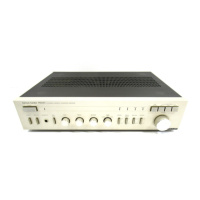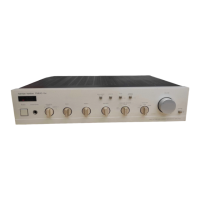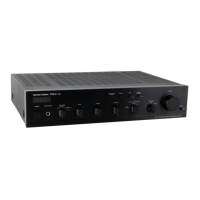10 CHANNEL CONFIGURATIONS
Channel Configurations and Audio Connections
In addition to the speaker connections, the
following steps must be followed for this con-
figuration:
• Connect the audio input source to the Main
Amp Input Jacks
⁄.
• Locate both the
Bridge 1 Amplifier Mode
Switch
‡ and the Bridge 2 Amplifier
Mode Switch
° on the rear panel, and use
a #1 Phillips screwdriver to carefully remove
the screws on either side of the plastic switch
guards that are around each of the switches.
• Remove both plastic guards and set them
aside with the screws.
• Slide both switches to the left so each one is
under the word “BRIDGE”.
• Replace the plastic switch guards with the
two screws so that both switches are secured
in their proper position.
Figure 3
Two Inputs/Four Outputs
In this configuration,there are four speaker pair
outputs, with three channels being fed by one
input source and one channel being fed by a
second, separate source.
Connect the speakers and audio inputs as fol-
lows:
• Connect the source that is to be fed to three
speakers to the
Main Amp Input Jacks ⁄.
The speakers that are to receive this signal
should be connected to the
Channel 1
Speaker Output Terminals
¢, the
Channel 2 Speaker Output Terminals ∞
and the Channel 4 Speaker Output
Terminals
£ using the standard speaker
wiring markings on the rear panel, as shown
in Figure 1.
• Connect the source that is to be fed to only
one channel to the
Channel 3 Input Jack
›.
• Move the
Channel 3 Separate Switch ¤
to the left so that it is under the word “ON”.
• Connect the speaker pair that will receive the
separate input feed to the Channel 3
Speaker Terminals
™ using the normal
wiring connections and markings as shown in
Figure 1.
• Make no changes to the
Amplifier Mode
Switches
‡/°. Leave them in their factory
positions with the switch over the word
“NORMAL”.
Two Inputs/Three Outputs
In this configuration,there are three speaker
pair outputs, with one high-power and one
lower-power pair receiving the same input,
while a second, separate input is sent to an
additional speaker pair.
Connect the speakers and audio inputs as
follows:
• Connect the source that is to be fed to the
high-power speaker set and the lower-power
speaker set to the Main Amp Input Jacks
⁄. Connect the higher-power speaker set as
shown in Figure 2 to the speaker terminals
marked “Bridge 1”. Make certain that the
connections for these speakers are made to
the proper “+” and “–“ terminals with the
two vertically oriented binding posts on each
side of the channel pair, as opposed to the
horizontal orientation of normal speaker con-
nections. DO NOT use the standard channel
output and polarity markings for these speak-
er connections.
• The speaker set that is to receive the lower
power signal should be connected to the
Channel 4 Speaker Output Terminals £
using the standard speaker wiring markings
on the rear panel as shown in Figure 2.
• Connect the source that is to be fed to only
one channel to the Channel 3 Input Jack
›.
• Move the
Channel 3 Separate Switch ¤
to the left so that it is under the word “ON”.
• Connect the speaker pair that will receive the
separate input feed to the Channel 3
Speaker Terminals
™ using the normal
wiring connections and markings as shown in
Figure 1.
• Locate the
Bridge 1 Amplifier Mode
Switch
‡ on the rear panel, and use a #1
Phillips screwdriver to carefully remove the
screws on either side of the plastic switch
guard that is around the switch.
• Remove the plastic guard and set it aside
with the screws.
• Slide the switch to the left so that it is under
the phrase “BRIDGE 1”.
• Replace the plastic switch guard with the two
screws so that the switch is secured in the
proper position.
Two Inputs/Two Outputs
In this configuration,the PA 4000 acts as a
dual-stereo amplifier, with two separate signals
being sent to high-power amplifiers.
Connect the speakers and audio inputs as follows:
• Connect one input source to the Main Amp
Input Jacks
⁄. Connect the speakers that
are to receive this signal to the speaker ter-
minals marked “Bridge 1”, as shown in
Figure 3. Make certain that the connections
for these speakers are made to the proper
“+” and “–“ terminals with the two vertically
oriented binding posts on each side of the
channel pair, as opposed
to the horizontal ori-
entation of normal speaker
connections. DO
NOT use the standard channel output and
polarity markings for these speaker connec-
tions.
• Connect the other input source to the
Channel 3 Input Jack ›. Connect the
speakers that are to receive this signal to the
speaker terminals marked “Bridge 2”, as
shown in Figure 3. Make certain that the con-
nections for these speakers are made to the
proper “+” and “–“ terminals with the two
vertically oriented binding posts on each side
of the channel pair, as opposed to the hori-
zontal orientation of normal speaker connec-
tions. DO NOT use the standard channel out-
put and polarity markings for these speaker
connections.
• Move the
Channel 3 Separate Switch ¤
to the left so that it is under the word “ON”.
• Locate both the Bridge 1 Amplifier Mode
Switch
‡ and the Bridge 2 Amplifier
Mode Switch
° on the rear panel, and use
a #1 Phillips screwdriver to carefully remove
the screws on either side of the plastic switch
guards that are around each of the switches.
• Remove both plastic guards and set them
aside with the screws.
• Slide both switches to the left so each one is
under the word “BRIDGE”.
• Replace the plastic switch guards with the
two screws so that both switches are secured
in their proper position.
Note for Audio Connections
When making connections with the RCA-type
plugs on interconnect cables, make certain to
gently
but firmly insert them into the jacks on
the back of the PA 4000. Loose connections
can cause intermittent sound and may damage
your speakers.The barrel assembly of some
high-quality RCA plugs may be very tight, and it
is important to ensure a proper connection
between the interconnection cable and the
input jack.

